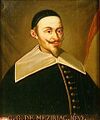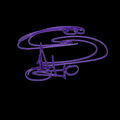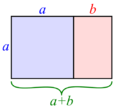Template:Selected anniversaries/October 9: Difference between revisions
No edit summary |
No edit summary |
||
| Line 1: | Line 1: | ||
<gallery> | <gallery> | ||
||892: Al-Tirmidhi dies ... scholar and hadith compiler. | ||892: Al-Tirmidhi dies ... scholar and hadith compiler. No pic. | ||
||1253: Robert Grosseteste dies ... English statesman, scholastic philosopher, theologian, scientist and Bishop of Lincoln. A. C. Crombie calls him "the real founder of the tradition of scientific thought in medieval Oxford, and in some ways, of the modern English intellectual tradition". Pic. | ||1253: Robert Grosseteste dies ... English statesman, scholastic philosopher, theologian, scientist and Bishop of Lincoln. A. C. Crombie calls him "the real founder of the tradition of scientific thought in medieval Oxford, and in some ways, of the modern English intellectual tradition". Pic. | ||
| Line 18: | Line 18: | ||
File:Leonhard Euler.jpg|link=Leonhard Euler (nonfiction)|1775: A paper by [[Leonhard Euler (nonfiction)|Leonhard Euler]], ''Speculationes circa quasdam insignes proprietates numerorum'', was presented at the Saint-Petersburg Academy. In this paper, he revisits the idea that has come to be called Euler's Phi function. He first introduced the idea to the Academy on Oct 15,1759 but did not include a symbol or name. Euler defined the function as "the multitude of numbers less than D, and which have no common divisor with it." (This is slightly different than the current definition which used Greatest Common Divisor is one). | File:Leonhard Euler.jpg|link=Leonhard Euler (nonfiction)|1775: A paper by [[Leonhard Euler (nonfiction)|Leonhard Euler]], ''Speculationes circa quasdam insignes proprietates numerorum'', was presented at the Saint-Petersburg Academy. In this paper, he revisits the idea that has come to be called Euler's Phi function. He first introduced the idea to the Academy on Oct 15,1759 but did not include a symbol or name. Euler defined the function as "the multitude of numbers less than D, and which have no common divisor with it." (This is slightly different than the current definition which used Greatest Common Divisor is one). | ||
||1801: Auguste Arthur de la Rive born ... physicist. | ||1801: Auguste Arthur de la Rive born ... physicist. Pic. | ||
||1806: Benjamin Banneker dies ... astronomer and surveyor. Pic. | ||1806: Benjamin Banneker dies ... astronomer and surveyor. Pic. | ||
| Line 36: | Line 36: | ||
File:Alfred Dreyfus age 76.jpg|1859: [[Alfred Dreyfus (nonfiction)|Alfred Dreyfus]] born. He will be wrongly convicted of treason during the [[Dreyfus affair (nonfiction)|Dreyfus affair]]. | File:Alfred Dreyfus age 76.jpg|1859: [[Alfred Dreyfus (nonfiction)|Alfred Dreyfus]] born. He will be wrongly convicted of treason during the [[Dreyfus affair (nonfiction)|Dreyfus affair]]. | ||
||1873: Karl Schwarzschild born ... physicist and astronomer. | ||1873: Karl Schwarzschild born ... physicist and astronomer. Pic. | ||
||1873: Charles Rudolph Walgreen born ... pharmacist and businessman, founded Walgreens. | ||1873: Charles Rudolph Walgreen born ... pharmacist and businessman, founded Walgreens. | ||
||1879: Max von Laue born ... physicist and academic, Nobel Prize laureate. | ||1879: Max von Laue born ... physicist and academic, Nobel Prize laureate. Pic. | ||
||1898: Heinrich Adolph Louis Behnke born ... mathematician. | ||1898: Heinrich Adolph Louis Behnke born ... mathematician. Pic. | ||
||1900: Joseph Friedman born ... inventor, invented the bendy straw. | ||1900: Joseph Friedman born ... inventor, invented the bendy straw. | ||
| Line 72: | Line 72: | ||
||1962: Milan Vidmar dies ... chess player and engineer. | ||1962: Milan Vidmar dies ... chess player and engineer. | ||
||1967: Cyril Norman Hinshelwood dies ... chemist and academic, Nobel Prize laureate. | ||1967: Cyril Norman Hinshelwood dies ... chemist and academic, Nobel Prize laureate. Pic. | ||
|| | ||1976: Yevgeny Zavoisky dies ... physicist known for discovery of electron paramagnetic resonance in 1944. He likely observed nuclear magnetic resonance in 1941, well before Felix Bloch and Edward Mills Purcell, but dismissed the results as not reproducible.[3][4] Zavoisky is also credited with design of luminescence camera for detection of nuclear processes in 1952 and discovery of magneto-acoustic resonance in plasma in 1958. Ouc, | ||
||1988: Felix Wankel dies ... engineer, invented the Wankel engine. | ||1987: William P. Murphy dies ... physician and academic, Nobel Prize laureate. Pic. | ||
||1988: Felix Wankel dies ... engineer, invented the Wankel engine. Pic. | |||
||1990: Georges de Rham dies ... mathematician, known for his contributions to differential topology. Pic: http://www-history.mcs.st-and.ac.uk/PictDisplay/De_Rham.html | ||1990: Georges de Rham dies ... mathematician, known for his contributions to differential topology. Pic: http://www-history.mcs.st-and.ac.uk/PictDisplay/De_Rham.html | ||
| Line 88: | Line 90: | ||
||2010: Alfred Jacobus (Alf) van der Poorten dies ... number theorist. Pic. | ||2010: Alfred Jacobus (Alf) van der Poorten dies ... number theorist. Pic. | ||
||2010: Maurice Allais dies ... economist and physicist, Nobel Prize laureate. | ||2010: Maurice Allais dies ... economist and physicist, Nobel Prize laureate. Pic. | ||
File:Purple Racer.jpg|link=Purple Racer (nonfiction)|2016: ''[[Purple Racer (nonfiction)|Purple Racer]]'' voted Picture of the Day by the citizens of [[New Minneapolis, Canada]]. | File:Purple Racer.jpg|link=Purple Racer (nonfiction)|2016: ''[[Purple Racer (nonfiction)|Purple Racer]]'' voted Picture of the Day by the citizens of [[New Minneapolis, Canada]]. | ||
Revision as of 16:15, 24 January 2019
1581: Mathematician and linguist Claude Gaspard Bachet de Méziriac born. He will do work in number theory and find a method of constructing magic squares.
1582: Astronomer and mathematician Michael Maestlin uses Copernican system of the solar system to predict imminent outbreak of crimes against mathematical constants.
1775: A paper by Leonhard Euler, Speculationes circa quasdam insignes proprietates numerorum, was presented at the Saint-Petersburg Academy. In this paper, he revisits the idea that has come to be called Euler's Phi function. He first introduced the idea to the Academy on Oct 15,1759 but did not include a symbol or name. Euler defined the function as "the multitude of numbers less than D, and which have no common divisor with it." (This is slightly different than the current definition which used Greatest Common Divisor is one).
1859: Alfred Dreyfus born. He will be wrongly convicted of treason during the Dreyfus affair.
1903: "Fightin'" Bert Russell agrees to fight three rounds of bare-knuckled boxing at World Peace Conference.
1918: CIA officer and author E. Howard Hunt born. Along with G. Gordon Liddy, Hunt will plot the Watergate burglaries and other undercover operations for the Nixon administration.
1948: Mathematician Joseph Wedderburn dies. He made significant contributions to algebra, proving that a finite division algebra is a field, and proving part of the Artin–Wedderburn theorem on simple algebras.
2016: Purple Racer voted Picture of the Day by the citizens of New Minneapolis, Canada.
2017: Artificial intelligence based on the Golden ratio develops genuine gratitude for Michael Maestlin's approximation of the Golden ratio.








